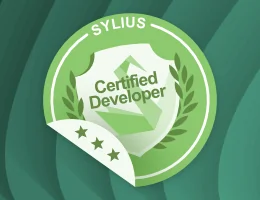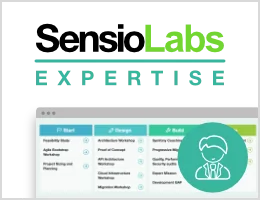Create a UX bundle
Tip
Before reading this, you may want to have a look at Best Practices for Reusable Bundles.
Here are a few tricks to make your bundle install as a UX bundle.
composer.json file
Your composer.json file must have the symfony-ux keyword:
1 2 3
{
"keywords": ["symfony-ux"]
}Assets location
Your assets must be located in one of the following directories, with a
package.json file so Flex can handle it during install/update:
/assets(recommended)/Resources/assets/src/Resources/assets
package.json file
Your package.json file must contain a symfony config with controllers defined,
and also add required packages to the peerDependencies and importmap (the list
of packages in importmap should be the same as the ones in peerDependencies):
1 2 3 4 5 6 7 8 9 10 11 12 13 14 15 16 17 18 19 20 21 22 23 24 25
{
"name": "@acme/feature",
"version": "1.0.0",
"symfony": {
"controllers": {
"slug": {
"main": "dist/controller.js",
"fetch": "eager",
"enabled": true,
"autoimport": {
"@acme/feature/dist/bootstrap4-theme.css": false,
"@acme/feature/dist/bootstrap5-theme.css": true
}
}
},
"importmap": {
"@hotwired/stimulus": "^3.0.0",
"slugify": "^1.6.5"
}
},
"peerDependencies": {
"@hotwired/stimulus": "^3.0.0",
"slugify": "^1.6.5"
}
}In this case, the file located at [assets directory]/dist/controller.js will be exposed.
Tip
You can either write raw JS in this dist/controller.js file, or you can
e.g. write your controller with TypeScript and transpile it to JavaScript.
Here is an example to do so:
Add the following to your
package.jsonfile:1 2 3 4 5 6 7 8 9 10 11 12 13 14
{ "scripts": { "build": "babel src --extensions .ts -d dist" }, "devDependencies": { "@babel/cli": "^7.20.7", "@babel/core": "^7.20.12", "@babel/plugin-proposal-class-properties": "^7.18.6", "@babel/preset-env": "^7.20.2", "@babel/preset-typescript": "^7.18.6", "@hotwired/stimulus": "^3.2.1", "typescript": "^4.9.5" } }Add the following to your
babel.config.jsfile (should be located next to yourpackage.jsonfile):1 2 3 4 5 6 7 8 9 10 11 12
module.exports = { presets: [ ['@babel/preset-env', { "loose": true, "modules": false }], ['@babel/preset-typescript', { allowDeclareFields: true }] ], assumptions: { superIsCallableConstructor: false, }, };- Run
npm installto install the new dependencies. - Write your Stimulus controller with TypeScript in
src/controller.ts. - Run
npm run buildto transpile your TypeScript controller into JavaScript.
To use your controller in a template (e.g. one defined in your bundle) you can use it like this:
1 2 3 4 5 6 7 8 9 10
<div
{{ stimulus_controller('acme/feature/slug', { modal: 'my-value' }) }}
{#
will render:
data-controller="acme--feature--slug"
data-acme--feature--slug-modal-value="my-value"
#}
>
...
</div>Don't forget to add symfony/stimulus-bundle:^2.9 as a composer dependency to use
Twig stimulus_* functions.
Tip
Controller Naming: In this example, the name of the PHP package is acme/feature and the name
of the controller in package.json is slug. So, the full controller name for Stimulus will be
acme--feature--slug, though with the stimulus_controller() function, you can use acme/feature/slug.
Each controller has a number of options in package.json file:
| Option | Description |
|---|---|
| enabled | Whether the controller should be enabled by default. |
| main | Path to the controller file. |
| fetch | How controller & dependencies are included when the page loads.
Use eager (default) to make controller & dependencies included in the JavaScript that's
downloaded when the page is loaded.
Use lazy to make controller & dependencies isolated into a separate file and only downloaded
asynchronously if (and when) the data-controller HTML appears on the page. |
| autoimport | List of files to be imported with the controller. Useful e.g. when there are several CSS styles depending on the frontend framework used (like Bootstrap 4 or 5, Tailwind CSS...). The value must be an object with files as keys, and a boolean as value for each file to set whether the file should be imported. |
Specifics for Asset Mapper
To make your bundle's assets work with AssetMapper, you must add the importmap
config like above in your package.json file, and prepend some configuration
to the container:
1 2 3 4 5 6 7 8 9 10 11 12 13 14 15 16 17 18 19 20 21 22 23 24 25 26 27 28 29 30 31 32 33 34 35 36 37 38 39
namespace Acme\FeatureBundle;
use Symfony\Component\AssetMapper\AssetMapperInterface;
use Symfony\Component\DependencyInjection\ContainerBuilder;
use Symfony\Component\DependencyInjection\Loader\Configurator\ContainerConfigurator;
use Symfony\Component\HttpKernel\Bundle\AbstractBundle;
class AcmeFeatureBundle extends AbstractBundle
{
public function prependExtension(ContainerConfigurator $configurator, ContainerBuilder $container): void
{
if (!$this->isAssetMapperAvailable($container)) {
return;
}
$container->prependExtensionConfig('framework', [
'asset_mapper' => [
'paths' => [
__DIR__ . '/../assets/dist' => '@acme/feature-bundle',
],
],
]);
}
private function isAssetMapperAvailable(ContainerBuilder $container): bool
{
if (!interface_exists(AssetMapperInterface::class)) {
return false;
}
// check that FrameworkBundle 6.3 or higher is installed
$bundlesMetadata = $container->getParameter('kernel.bundles_metadata');
if (!isset($bundlesMetadata['FrameworkBundle'])) {
return false;
}
return is_file($bundlesMetadata['FrameworkBundle']['path'] . '/Resources/config/asset_mapper.php');
}
}
